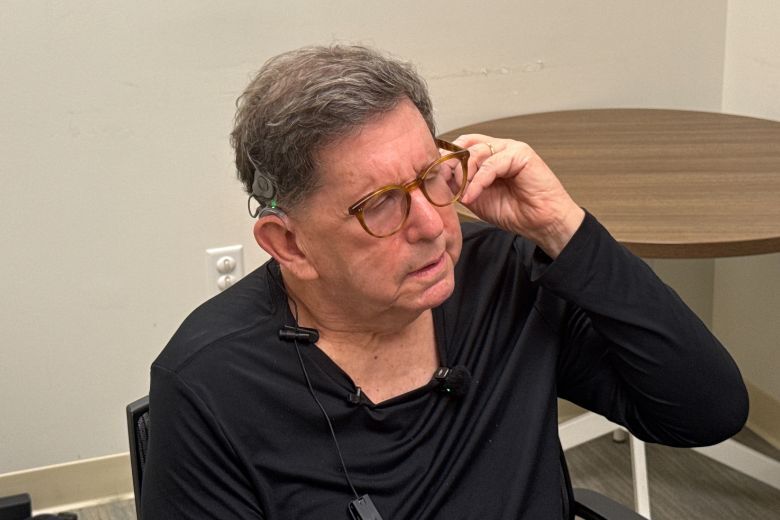
It has been decades since he was able to hear out of his right ear, but thanks to an updated cochlear implant, now he can hear his wife and family clearly.
WTOP was inside the doctor’s office as that implant was being turned on.
Several weeks postsurgery, Dr. Michael Feuerstein sat there hearing chimes and beeps at different volumes trying to calibrate his new cochlear implant for his hearing. He will eventually be able to change some of those settings using an iPhone app.
“Are you ready? OK,” said Melissa Blumgart, an audiologist with MedStar Health in Northwest D.C.
“OK sir, can you hear my voice?” she asked.
“I hear it, and I hear mine,” he responded.
That’s the exact moment the state-of-the-art cochlear implant was turned on for the 75-year-old.
“I couldn’t hear out of this ear for 20 years, actually,” Feuerstein said. “I missed out on all these conversations. Even though I had the hearing aid in my left ear, I always had to say, ‘Why, what?’”
He lost his hearing during radiation treatment for a brain tumor in 2003. The new cochlear implant is the first smart implant that runs its own firmware, similar to an iPhone. It can be upgraded without having to do any more surgeries.
“I imagine him now being able to keep this implant for the rest of his life, hopefully take advantage of upgrades that the company comes out with over time,” Blumgart told WTOP.
The implant has internal firmware that can be updated without the need for more surgery to get to the cochlear device. It’s a new development that Blumgart told WTOP has been a decade in the making.
Previously people who received cochlear implants could only access any upgrades in technology through the sound processor, the external part of the cochlear implant. The company claims their new smart implant has upgradable firmware, “which for the first time will enable Cochlear recipients to access future innovation through both their implant and sound processor.”
The implant, the Cochlear Nucleus Nexa System, has the smallest sound processor in the world as well as a self-monitoring system that can be downloaded as an app on the patient’s smartphone, according to the company.
It was installed through surgery in August at MedStar Georgetown University Hospital by Dr. Michael Hoa, the medical director of the Cochlear Implant Program, and Dr. Jeffrey Kim, the director of neurotology and otology.
“This new device allows a patient’s unique hearing settings to be stored on the actual implant in addition to the sound processor the patient wears,” Hoa said in a statement. “That means if the processor is lost or damaged, the patient can still stay connected to sound.”
As the device was initially turned on, Feuerstein noticed that the people in the room speaking, including himself, sounded like robots. Blumgart said that’s completely normal when using a new implant, as the brain tries to process the new way of hearing.
While it does take time to get familiar with the new implant, Feuerstein showed that his hearing had already dramatically improved within the first half hour of using it.
He thought the device was malfunctioning but actually he could just hear someone speaking out in the hall through a closed door. Shelly Feuerstein, his wife, was at the appointment and had tears of joy when he could clearly hear her voice.
“I’m getting very emotional about it because it’s incredible. It’s just, it’s like a miracle. He’s missed out on so much,” she said, almost in tears.
“When we go out to dinner with friends, he can’t follow conversations. Our 6-year-old granddaughter said to me, ‘I’m going to be so happy when Papa can hear,’” she said. “It’s very exciting for all of us for him to be able to hear.”
Get breaking news and daily headlines delivered to your email inbox by signing up here.
© 2025 WTOP. All Rights Reserved. This website is not intended for users located within the European Economic Area.